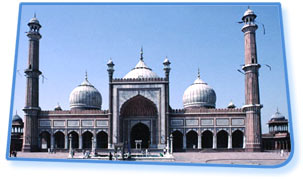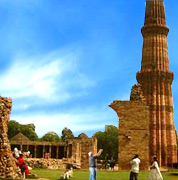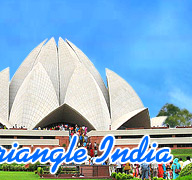 Built by Shah Jahan, Jama Masjid was begun in 1650 and it took hard work of six years of more than 5000 workers to build the largest mosque in India. It was customary for the emperor and his courtiers to go to the mosque every Friday for attending 'Jumme ki namaaz', the congressional prayers. The magnificent example of Mughal architecture, Jama Masjid has three massive gateways - the largest and highest being on the east. This gateway was reserved exclusively for the stately appearance of the emperor.
Built by Shah Jahan, Jama Masjid was begun in 1650 and it took hard work of six years of more than 5000 workers to build the largest mosque in India. It was customary for the emperor and his courtiers to go to the mosque every Friday for attending 'Jumme ki namaaz', the congressional prayers. The magnificent example of Mughal architecture, Jama Masjid has three massive gateways - the largest and highest being on the east. This gateway was reserved exclusively for the stately appearance of the emperor.The red stone of the main courtyard sprawls across 408 square feet with a large marble tank in the center, which serves the purpose of making the water available for the devotees to wash themselves before offering prayers in the mosque. The three onion shaped domes made of white marble adorn the main mosque. They are inlaid with stripes of black slate. There are 130 ft. high minarets on the north and south of the mosque complex ready to offer its guests a fabulous bird's eye-view of the city. Besides the exemplary architecture, Jama Masjid has great religious significance as it houses the sacred hair believed to have come from the beard of the Prophet and a chapter of the Holy Quran, said to be written by Him.
Hazrat Nizamuddin Auliya Dargah:
Situated near to Humayun's tomb, is the famous shrine of the sufi saint Nizam-ud-din Auliya, who had come to India, all the way from Bukhara. Many other tombs surround the tank inside the premises of the tomb. The devotees of the great saint believe that there was a controversy between the rulers of Tughlaqabad and the saint over building this tank and the saint had already prophesized that the city of Tughlaqabad will never flourish. Time proved his prophesies to be true.
Besides the main tomb of the Sufi saint, the shrine also encompasses the tombs of Amir Khusaru, the famous Urdu poet and Jahanara, the beloved daughter of Shah Jahan who designed Chandni Chowk. The best time to visit the place is around sunset on Thursdays, as people throng here during that time for the special worship and 'qawwali' singers perform melodiously after the evening prayers.
Moth-Ki-Maszid:
An interesting legend attaches itself to the place, which speaks volumes of the attitude of Sikander Lodi of treating everything with care and not overlooking even the minutest thing of use and the wisdom and the respect and devotion for his master of his prized minister, Wazir Miya Bhoiya. In the 16th century, the area where the mosque now stands was a forestland. One day, as Sikander and Miyan Bhoiya were strolling together, the king's eyes fell on a grain of moth ki dal (a kind of lentil). He picked it up with great care and presented it to his minister.
Not to be outdone, his minister accepted the gift with gratitude and humility and to safeguard this little gift he got from His Royal Highness, he planted the seed in his garden. With due care, the seed gave rise to a yield of 200 grains in the very first year! A seed revolution came through that little seed and within a few years, there was such a surplus of produce cultivated from that single grain that Wazir Miyan Bhoiya decided to build a mosque to celebrate the event and invited Sultan Sikander in its inauguration. The king was so pleased with the wisdom of his minister that he named the building, Moth ki Masjid (translated as the mosque from lentil).
Jamali-Kamali Mosque & Tomb:
Jamali Kamali Maszid was built between 1528 and 1556 and bears a more typical Mughal appearance with a red sandstone structure and white stone outlining the details to compliment the red color and lend its sobriety to the place of worship. The façade of the sacred haven is made up of an arcade of four centre point arches that rest on thick piers. To relieve the façade of its starkness, the rosettes in the spandrels of the arches ornament it.
There are also two-tier blind arches on the piers and a row of smaller blind arches that run in a line above the arches. The central arch that leads to the mehrab is not bigger than other arches but has been highlighted by adorning it with a tall pishtak-like façade that has engaged columns. A squat masonry dome typical of Rajput and earlier Sultanate architecture covers the area behind this arch.
Quwwatu'l Islam Maszid or Qutub Mosque:
The word 'Quuwat-ul-Islam' means 'the might of Islam'. It was the first mosque in India built by Qutub-ud-din Aibak, the founder and first Sultan of the Slave dynasty, and thus, was also called as 'Qutub Mosque'. This mosque does not include much of Islamic elements, as it was constructed using the ruins of the building material from 27 Hindu and Jain temples that had been demolished by the first Muslim rulers of India, which were situated in the Rajput citadel they had occupied. It is considered unique because it uses the pillars of Hindu temples with a number of Hindu motifs carved on them. The mosque and its complex were built between 1193 and 1198. Its associated buildings and extensions include much-reputed Qutub Minar, Iron Pillar of Mehrauli that dates back to the 4th century is devoted to Lord Vishnu, a gate and several tombs.
Even the later additions to the mosque continued to make use of the Hindu columns until they were exhausted and only then, new carvings were done to maintain the harmony and stylistic unity of the interiors. However, one can see a visible influence of Timurid style of mosque architecture in the large arched screen placed across the main prayer hall that had been added by Aibek in 1198. is, however, a clear reference to the Timurid style of mosques.
Khirki-Ki-Maszid:
Unique in architectural style, Khirki Masjid is only one of its kinds. It is a small quadrangle-shaped mosque closed on top unlike the usual style of mosques in which there is an open courtyard for the devotees to offer their prayers to God. Khirki Masjid has beautiful convoluted latticework on its windows, which were principally carved stone screens and can be said to be the precursor of later magnificent Mughal buildings marked by the intricate patterns and delicate facades. The pillars and brackets of the mosque show a heavy native influence, which can be attributed to the ample use of the local artisans, trained in their own schools of architecture. The roof of the Khirki Masjid is divided into squares with groups of small domes on them, through which sunlight found its way to the inner sanctum of the mosque.
The mosque made use of the rubble masonry, which had been plastered externally. There are splendid steps leading up to the place of worship for Muslims built by Khan-I-Jahan Junan Shah, the prime minister of Ferozshah Tughlaq in 15th century. It is believed that it was once his private place of worship. The main significance of the mosque lies in the fact that it is credited to be a link between the late architecture of the Lodhi rulers (the last dynasty of the Delhi Sultanate period) and the highly ornate massive structures of the Mughal architecture.












